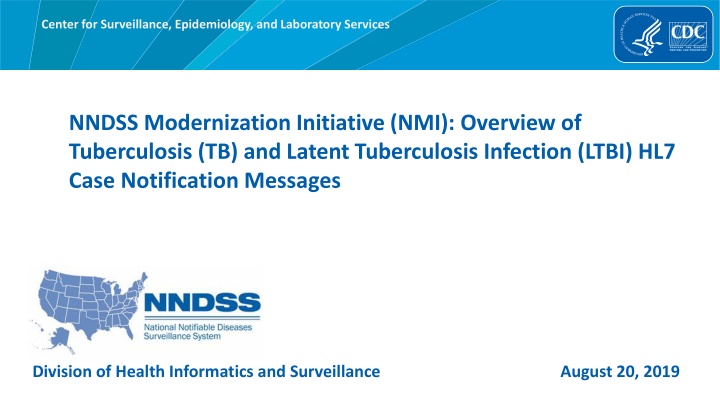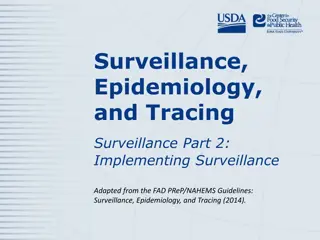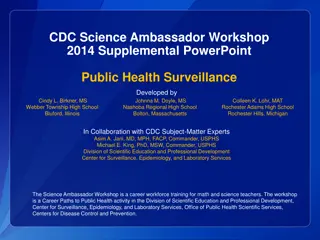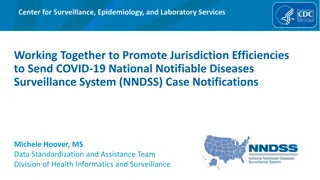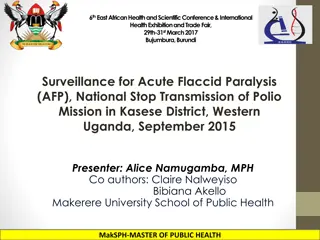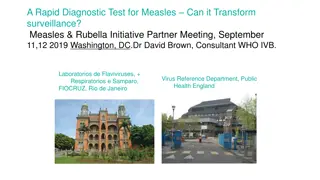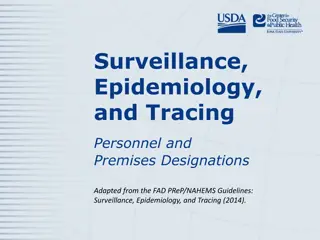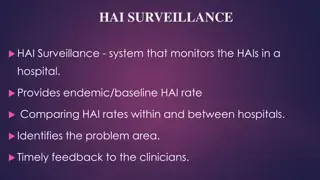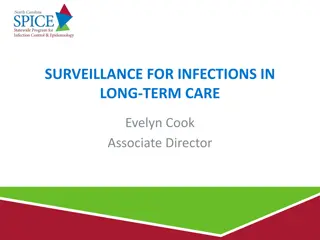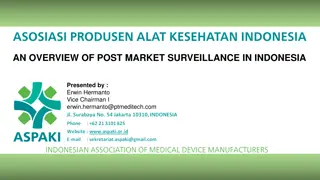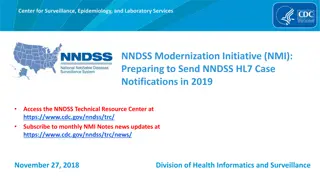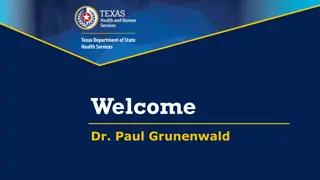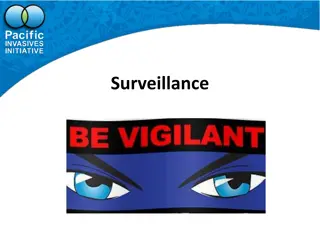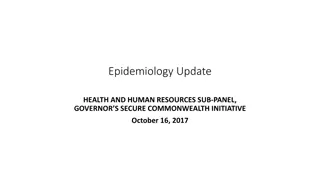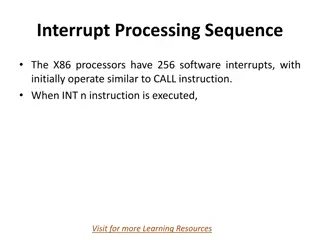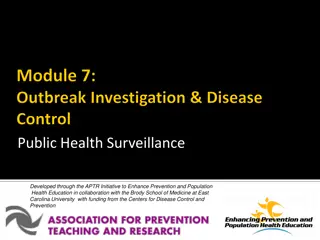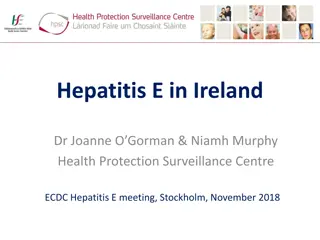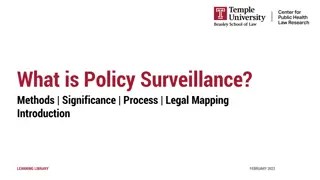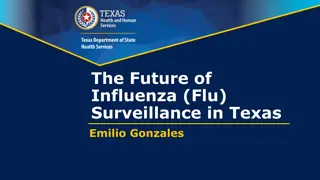Center for Surveillance, Epidemiology, and Laboratory Services NMI Overview
The Center for Surveillance, Epidemiology, and Laboratory Services NMI provides an overview of Tuberculosis (TB) and Latent Tuberculosis Infection (LTBI) through HL7 Case Notification Messages. The initiative covers announcements, state panel discussions, and new conditions added to the 2019 event code list for CDC notifications. Updates to MMG value sets and reminders for case notifications are also highlighted.
Download Presentation

Please find below an Image/Link to download the presentation.
The content on the website is provided AS IS for your information and personal use only. It may not be sold, licensed, or shared on other websites without obtaining consent from the author.If you encounter any issues during the download, it is possible that the publisher has removed the file from their server.
You are allowed to download the files provided on this website for personal or commercial use, subject to the condition that they are used lawfully. All files are the property of their respective owners.
The content on the website is provided AS IS for your information and personal use only. It may not be sold, licensed, or shared on other websites without obtaining consent from the author.
E N D
Presentation Transcript
Center for Surveillance, Epidemiology, and Laboratory Services NNDSS Modernization Initiative (NMI): Overview of Tuberculosis (TB) and Latent Tuberculosis Infection (LTBI) HL7 Case Notification Messages August 20, 2019 Division of Health Informatics and Surveillance
Agenda Welcome and Announcements Overview of Tuberculosis (TB) and Latent Tuberculosis Infection (LTBI) HL7 Case Notification Messages. Adam J. Langer, NCHHSTP, Division of Tuberculosis Elimination, CDC Sandy Price, NCHHSTP, Division of Tuberculosis Elimination, CDC State Panel on Barriers, Challenges, and Lessons Learned while Piloting TB/LTBI HL7 Case Notification Messages. Arizona, Georgia, and Oregon Questions and Answers 2
Center for Surveillance, Epidemiology, and Laboratory Services NMI Announcements Lesliann Helmus, MSPH, CHTS-CP Associate Director for Surveillance Michele Hoover, MS Lead, State Implementation and Technical Assistance
New Conditions Added to 2019 Event Code List CDC received approval from the Office of Management and Budget (OMB) to receive case notifications for the following conditions: Candida auris, clinical (event code 50263) * Candida auris, colonization/screening (event code 50264) * Carbapenemase-Producing Carbapenem-Resistant Enterobacteriaceae (CP-CRE) (event code 50244) * Carbon Monoxide Poisoning (event code 32016) * Respiratory Syncytial Virus-Associated Deaths (event code 11646) * Enterotoxigenic E.coli (ETEC) (event code 11566) (EIP sites only) * Gen v2 Only 4
Reminder: Please send notifications to CDC for all 2019 cases of the above conditions. Use the Generic v2 message mapping guide until disease- specific message mapping guides are available. CDC will post an updated 2019 NNDSS full and Generic V2 only event code lists to the MMG Related Documentation Section of the NNDSS Technical Resource Center at https://ndc.services.cdc.gov/event-codes-other-surveillance- resources/. 5
Recent Updates to Finalized MMG Value Sets Value set updates to the Generic v2.0 MMG (impacts all messages) City Condition-specific value sets for Final guides: Mumps, Pertussis, and Varicella MMGs Vaccine Event Information Source (NND): Primary Care Provider Medical Chart STD MMG Lab Test Type (STD): Other Chancroid Test Type (LAB728) Other Chlamydia Test Type (LAB729) Other Gonorrhea Test Type (LAB730) Other Syphilis Test Type concepts (LAB731) MMGs available on the HL7 Resource Center at https://ndc.services.cdc.gov/message-mapping-guides/. 6
NMI Implementation Status Aug 20, 2019 NH WA VT ME AK ND MT MN MA OR NY WI RI ID SD MI CT WY PA NYC NJ IA OH CA NE DE NV IN HI IL WV UT VA DC MD CO KS MO KY NC TN SC OK AR AZ NM MS AL GA LA TX PR FL Piloting Onboarding Total of 1 (state) Total of 5 (states) Production Total of 39 (38 states + NYC) 7
Finalized Guides Onboarding Open to All Onboarding For Pilots Only Onboarding On Hold Arboviral v1.3 FDD Mumps Gen v2 TB/LTBI Pertussis Hepatitis Malaria Varicella Babesiosis Trichinellosis STD CS 8/20/2019 8
Piloting Status Message Mapping Guides (MMGs) Piloting States Piloting RIBD 3 GA, KS, OR Lyme/TBRD 5 FL, ID, IL, MI, OR HAI MDRO 3 CO, MI, OR Measles/Rubella/CRS 4 AL*, AZ, FL, OR Total # of Individual States 10 AL, AZ, CO, FL, GA, ID, IL, KS, MI, OR * Measles Only 8/20/2019 9
NNDSS HL7 Message Mapping Guide Estimated Timeline 2019 Jan-Mar Apr-Jun Jul-Sep Oct-Dec J1 J2 J3 J4 J5 F1 F2 F3 F4 M1 M2 M3 M4 A1 A2 A3 A4 A5 M1 M2 M3 M4 J1 J2 J3 J4 J1 J2 J3 J4 J5 A1 A2 A3 A4 S1 S2 S3 S4 O1 O2 O3 O4 O5 N1 N2 N3 N4 D1 D2 D3 D4 Arboviral IN PRODUCTION Generic V2 IN PRODUCTION Hepatitis IN PRODUCTION Sexually Transmitted Diseases IN PRODUCTION Congenital Syphilis IN PRODUCTION Mumps IN PRODUCTION Pertussis IN PRODUCTION Varicella IN PRODUCTION Tuberculosis Babesiosis Trichinellosis Lyme/Tick-borne Rickettsial Disease (TBRD) Foodborne Diarrheal Disease Respiratory and Invasive Bacterial Disease HAI MDRO Malaria Measles Rubella Congenital Rubella Syndrome Carbon Monoxide Bacterial Special Pathogens Lead Listerosis = Final Guide Available Development Pre-Pilot Piloting Preparation for Production Production 10
National Center for HIV/AIDS, Viral Hepatitis, STD, and TB Prevention Division of Tuberculosis Elimination Tuberculosis (TB) and Latent TB Infection (LTBI) HL7 Case Notification Message Adam J. Langer, DVM MPH DACVPM Surveillance, Epidemiology, and Outbreak Investigations Branch Sandy Price, PMP Data Management, Statistics, and Evaluation Branch
Why Are We Doing This? Report of Verified Case of TB (RVCT) last revised in 2009 Quality assurance issues identified with some questions since 2009 New anti-TB drugs available New drug-susceptibility testing (DST) methods available 2015 National Action Plan for Multidrug-Resistant (MDR) TB 5-year goals Capture molecular DST results for all cases Record information on MDR TB treatment Store information to distinguish primary and secondary resistance Implement National Notifiable Diseases Surveillance System (NNDSS) Modernization Initiative and Council of State and Territorial Epidemiologists (CSTE) position statements
Implementation Timeline August 2019: 2020 RVCT and message mapping guide (MMG) available for implementation and onboarding Fall 2019 Instruction manual and training resources released In-person training requests accommodated as travel budgets allow December 2020: MMG should be implemented for existing data elements for cases counted starting in January 2020 December 2021: All 2020 RVCT data elements expected for cases counted starting in January 2021 Reporting areas that cannot meet this timeline should contact CDC s Division of TB Elimination (DTBESupport@cdc.gov) to discuss individual situations
Key Implementation Points: MMG Structure TB/LTBI message TB/LTBI MMG Generic V2 MMG Both TB disease and LTBI cases reported using same MMG TB disease is nationally notifiable and case reporting is required under the TB cooperative agreement LTBI is under standardized surveillance and reporting is encouraged, but not required Considerable overlap in data elements between TB disease and LTBI
Key Implementation Points: Repeating Groups Tuberculin skin test (TST)/Non-drug susceptibility testing (DST) lab results Chest radiograph or other chest imaging study Previous TB or LTBI diagnoses Epidemiologically linked cases Phenotypic (growth-based) DST Genotypic (molecular) DST
TST/Non-DST Lab Results Repeating Group At least one result is required for each of these test types: TST Interferon-gamma release assay (IGRA) [must specify IGRA type] Sputum smear Sputum culture Sputum nucleic acid amplification (NAA) test HIV serology If one of the above tests was not done, report it as Not Done HIV-positive patients should have CD4 count reported Diabetics should have hemoglobin A1c or fasting blood glucose reported
Chest Radiograph or Imaging Study Repeating Group At least one result is required for each of these test types: Plain Chest X-Ray Computerized Tomography (CT) Scan If one of the above tests was not done, report it as Not Done Other types of chest imaging studies can be reported
Previous TB or LTBI Repeating Group Report previous documented diagnoses of either LTBI or TB disease Only one previous LTBI diagnosis is allowed Multiple past TB disease diagnoses accepted Include state case number for previous diagnoses, if available Recurrent TB disease cases Diagnosed 12 months after treatment completion for prior TB diagnosis Do not report recurrent cases as new case (change from current practice) Do reopen the original case report and update it
Epidemiologically Linked Cases Repeating Group Report all TB disease and LTBI cases epidemiologically linked to this case Contact investigation Source case investigation Genotype cluster investigation Unlimited number of state case numbers may be entered To signify that no linked cases were found Enter 999999999 in standard state case number format (e.g., 2019-GA-999999999) if an epidemiologic investigation was done, but no linked cases were found Leave blank if an epidemiologic investigation was not done, and therefore no linked cases were found
Phenotypic (Growth-Based) DST Repeating Group Report DST results for all drugs listed in the Drug Name value set Isoniazid Rifampin Pyrazinamide Ethambutol Streptomycin Rifabutin Rifapentine Ethionamide Amikacin Kanamycin Capreomycin Ciprofloxacin Levofloxacin Ofloxacin Moxifloxacin Cycloserine Para-Amino Salicylic Acid Linezolid Bedaquiline Delaminid Clofazimine Report result as Not Done if no results available for a given drug Option to specify other drugs on case-by-case basis, as needed New TB drugs will be added to value set as they become available
Genotypic (Molecular) DST Repeating Group Two major categories of molecular DST tests Nonsequencing Sequencing All test types provide a qualitative result Mutation detected Mutation not detected
Genotypic (Molecular) DST Repeating Group (cont) Sequencing methods sometimes provide more information, including: Specific nucleic acid or amino acid changes caused by a mutation Whether mutation was an insertion, deletion, or just indel Include initial result for each gene/test type combination as well as any subsequent tests where the result changed, e.g.: Initial test reports nonsequencing result for rifampin gene Subsequent sequencing-based test for same gene Report both test results, even if the result is the same Report subsequent tests for same gene only if result changes, e.g., a mutation is detected that was not found on previous tests
Key Implementation Points: Census Tract Reporting address should be reported to the level of census tract using U.S. Census Bureau 11-digit GEOID codes Geocoding options Manual geocoding: Enter reporting address in Census Geocoder (https://geocoding.geo.census.gov/) and copy/paste 11-digit GEOID from Census Tracts section of results Automated geocoding: Use Census Geocoder application programming interface (API) to facilitate automatically geocoding addresses (https://geocoding.geo.census.gov/geocoder/Geocoding_Services_API.html)
Key Implementation Points: Nativity Report patient s country of birth regardless of current citizenship or legal residency status Regardless of country of birth, report whether patient was legally eligible for U.S. citizenship at birth (i.e., birthright citizenship, U.S.-born ) These data are needed to select appropriate population denominator data when calculating incidence rates
Key Implementation Points: Country of Residence Country of residence should be determined using established CSTE guidance Some U.S. territories and freely associated states are U.S. reporting areas, but have their own value set entries (e.g., Puerto Rico, Republic of Palau) Cases with countries of residence outside of U.S. reporting areas should still be reported if diagnosed and started on treatment in the United States Report whether the patient received TB treatment in a U.S. reporting area for 90 days as these data are used for programmatic purposes CDC Division of TB Elimination can assist with interpreting residency guidelines if needed
Key Implementation Points: Industry and Occupation All three parts of the question should be completed Has patient ever worked as a healthcare worker, correctional facility employee, or migrant/seasonal worker Usual occupation Usual industry Only the narrative (free text) description of the usual occupation and industry are required coding is optional Guidance and training will be available to help ensure that the free text entries are able to be coded by CDC
Key Implementation Points: Binational Criteria Report all cases that meet CSTE or CDC TB-specific criteria for designation as a binational case Exposure to suspected product from Canada or Mexico Has case contacts in or from Mexico or Canada Potentially exposed by a resident of Mexico or Canada Potentially exposed while in Mexico or Canada Resident of Canada or Mexico For cases that meet CDC TB-specific binational case criteria, but do not fit one of the established CSTE binational categories, select Other situations that may require binational notification or coordination of response
Key Implementation Points: MDR TB For TB disease cases, report whether the case was treated as MDR TB Some cases are difficult to confirm with culture methods (e.g., children) MDR TB treatment might be prescribed empirically when there is a history of exposure to an MDR TB case Answer yes if the case was clinically treated as MDR TB, even if DST results do not demonstrate MDR TB All cases treated as MDR TB should have the MDR TB supplemental form completed in its entirety Submission of supplemental form using HL-7 message encouraged Web-based submission method will also be available
Key Implementation Points: TB Disease/LTBI Differences DST repeating groups omitted from LTBI case messages (LTBI cases are by definition culture-negative) Case outcome data elements streamlined for LTBI as compared to TB disease Initial drug regimen For TB disease, drugs are listed individually and any treatment regimen variation can be documented For LTBI, five CDC-recognized treatment regimens are listed, plus the option to respond other and specify a different regimen
Key Implementation Points: Reason Therapy Stopped Structure of this question differs between TB disease and LTBI cases ensure that the correct question is used for each condition Died vs. Adverse Treatment Event vs. Dying Died: Patients who were taking their TB medication right up until their death, or who had treatment discontinued because of a severe adverse event that subsequently led to death Adverse Treatment Event: Patients whose treatment was permanently discontinued because of an adverse treatment event, but who survived Dying: Patients whose treatment was stopped prior to death only because death was imminent
For more information, contact CDC s Division of TB Elimination: Email: DTBESupport@cdc.gov Phone: 888-300-4261 The findings and conclusions in this report are those of the authors and do not necessarily represent the official position of the Centers for Disease Control and Prevention.
Center for Surveillance, Epidemiology, and Laboratory Services Barriers, Challenges, and Lessons Learned while Piloting the TB/LTBI HL7 Case Notification Messages Arizona Department of Health Services Georgia Department of Public Health Oregon Health Authority Public Health Division
TB State Panelists Public Health Agency (PHA) PHA Contacts PHA Surveillance System Arizona Department of Health Amy Lai Evan Timme Medical Electronic Disease Surveillance Intelligence System (MEDSIS)* Georgia Department of Public Health Skip Frick Grace Njuguna State Electronic Notifiable Disease Surveillance System (SENDSS)* Oregon Health Authority: Oregon Public Health Division Michelle Barber Kiley Ariail Orpheus* * Custom System 33 8/12/2019
Panel Topics Data Elements Mapping Best Practices and Lessons Learned Technical Assistance 34
Q & A 35
Subscribe to monthly NMI Notes news updates at https://www.cdc.gov/nndss/trc/news/ Access the NNDSS Technical Resource Center at https://www.cdc.gov/nndss/trc/ Request NNDSS technical assistance or onboarding at edx@cdc.gov Next NNDSS eSHARE is September 17, 2019 details at https://www.cdc.gov/nndss/trc/onboarding/eshare.html For more information, contact CDC 1-800-CDC-INFO (232-4636) TTY: 1-888-232-6348 www.cdc.gov The findings and conclusions in this report are those of the authors and do not necessarily represent the official position of the Centers for Disease Control and Prevention.
